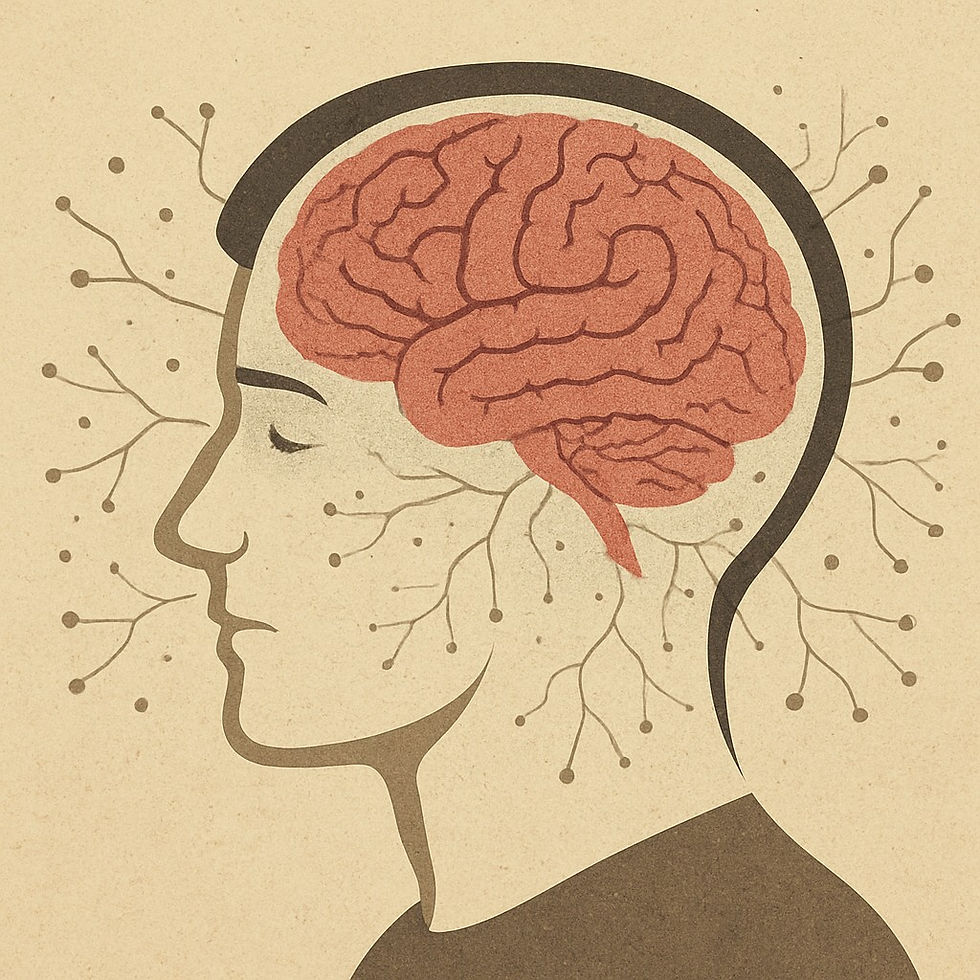A Brain That Holds Too Much: The Double-Edged Gift of Autistic Neurodensity
- Tim Aiello, MA, LPC, NCC, ADHD-CCSP, ASDCS

- Apr 16
- 4 min read
By Tim Aiello, MA, LPC, NCC, ADHD-CCSP, ASDCS

For many of us who are autistic, the phrase “too much” isn’t just a feeling—it’s a neurological reality. Too many thoughts, too many sensations, too much detail, too much everything. For years, I thought this was a flaw in my character. Now, I understand it’s a feature of my brain.
Emerging research suggests that autistic individuals often possess brains with more neurons, greater local connectivity, and higher synaptic density—especially in certain regions of the brain (Courchesne et al., 2011; Lainhart, 2015). In simple terms: our brains are wired to take in and hold more information at once. And while that can be a gift, it’s also incredibly hard to live with in a world not built for that kind of intensity.
A Denser Brain, A Deeper Experience
Studies using postmortem analysis and MRI scans have shown that autistic individuals often exhibit increased neuron numbers in the prefrontal cortex—the region responsible for higher-order thinking, decision-making, and social processing (Courchesne et al., 2011). This may contribute to our often extraordinary pattern recognition, deep focus, and attention to detail. It’s why so many of us excel in fields requiring complex systems thinking, data analysis, music, coding, or art.
But more neurons don’t just mean “more thinking”—they mean more processing. It’s like having ten tabs open in your brain when someone else has three—and all of them are playing sound.
This can make simple social exchanges overwhelming. When a neurotypical person walks into a room, they might notice the people, the conversation, and the vibe. When I walk into a room, I notice the flicker of fluorescent lighting, the rhythm of background noise, the subtle shifts in people’s facial expressions, and how my clothes feel against my skin—all before anyone says a word.
And once someone does speak, my brain wants to analyze their tone, word choice, body language, and what they really meant—sometimes to the point of emotional paralysis.
The Price of Holding Too Much
This neurodensity—this ability to process so much—often comes at a cost. Our brains burn more energy doing what others take for granted. That can look like:
Cognitive Overload: Because we’re not filtering out as much irrelevant data, everything becomes equally loud and equally important.
Decision Paralysis: With so much data, making a simple choice can feel like solving a logic puzzle.
Emotional Burnout: Holding multiple perspectives, feelings, and implications all at once can feel like drowning in empathy without a life raft.
This may help explain why autistic burnout is so common. We’re not broken—we’re overloaded. And we often don’t have the infrastructure of rest, support, or understanding that neurotypical people do.
The Gift Inside the Overwhelm
Still, I’ve come to believe that there’s magic in this neurological complexity. The same brain that exhausts me is also the one that sees patterns where others don’t, that feels truth in my gut, that can build a world of meaning out of a single conversation.
I remember once being told, “You’re just too sensitive.” But what if that sensitivity is the whole point? What if it’s a finely-tuned system meant not for suppression, but for connection?
There is incredible richness in the autistic mind. We think in depth, love in detail, and live in layers. Yes, it makes life more difficult. But it also makes it more textured, more meaningful, and sometimes, breathtakingly beautiful.
Navigating a Complex Mind in a Simple World
If you relate to this, I want you to know: your brain isn’t “too much.” It’s just misunderstood. You may live in a world that prefers convenience over complexity, speed over depth, and superficial charm over genuine understanding—but your mind is no less valid because of that.
To thrive, we must learn to regulate without shrinking. We need strategies that respect our depth without forcing us to go shallow.
That’s why I return again and again to Polyvagal Theory. When my nervous system is regulated—when I feel safe enough to slow down—I can move from panic to presence. I can stop filtering the world through survival, and start embracing the gifts that come with seeing so much.
A Final Word
More neurons. More connections. More everything. It’s not a glitch in the system—it is the system. And while it may mean we need more rest, more recovery, and more self-compassion, it also means we’re uniquely equipped to notice, to care, to create, and to matter.
Let’s stop apologizing for how much we hold. And start honoring it instead.
References
Courchesne, E., Mouton, P. R., Calhoun, M. E., Semendeferi, K., Ahrens-Barbeau, C., Hallet, M. J., ... & Pierce, K. (2011). Neuron number and size in prefrontal cortex of children with autism. JAMA, 306(18), 2001–2010.
Lainhart, J. E. (2015). Brain imaging research in autism spectrum disorders: in search of neuropathology and health across the lifespan. Current Opinion in Psychiatry, 28(2), 76–82.
Porges, S. W. (2011). The Polyvagal Theory: Neurophysiological Foundations of Emotions, Attachment, Communication, and Self-Regulation. Norton & Company.




Comments